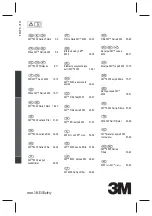
SECTION 2-6
EQUIPMENT DESCRIPTION
FLOWMAX RO MANUAL REV: B 05/1999
USFilter
United States Filter Corporation
water is produced from each and collected from the two pressure vessel product ports, which are
connected together outside of the pressure vessel in a common product water header. The water
that is not recovered is passed out of the vessels as reject, along with the dissolved and
suspended solids. This water is then collected into a common first stage reject header ( or reject
header) and directed to the feed of the third vessel which is plumbed in series behind the first
two vessels, where the process is again repeated. The second stage product is added to the first
stage product. The second stage reject is directed through a control valve and disposed of along
with most of the dissolved and suspended solids.
Recovery Limitations
As previously described, product recovery is the ratio of water volume recovered as product
water compared to the volume of water supplied to the RO unit as feed water. Naturally, in an
ideal situation you would like to recover all of the water, but this is not practical for several
reasons as described below.
If all of the water that was processed were converted to product water, there would be no water
available to flush the membrane surface area free of remaining suspended solids. Consequently,
the suspended solids would build up on the surface of the membrane and gradually restrict the
flow of product water until no permeate or product water could be produced.
The presence of some dissolved solids such as silica, barium, strontium or calcium and
magnesium when present with carbonate or sulfate ions restricts the recovery of an RO unit more
than other dissolved solids, due to their limited solubility in water. For example, the presence of
silica (SiO
2
) in the feed water is often times the limiting factor in RO recovery, because it starts
to precipitate out of solution when it reaches a concentration of 100-120 PPM. That means that
if the feed water contains 30 PPM of SiO
2
then the recovery of product water is limited to about
75%, because the SiO
2
concentration will be increased by 4 times which will result in a silica
concentration in the RO reject of approximately 120 PPM which is the limit of it's solubility. If
you tried to recover 80% of the water, the concentration of SiO
2
would reach 5 times the feed
water concentration or approximately 150 PPM and start to precipitate, fouling the membrane
surface.













































